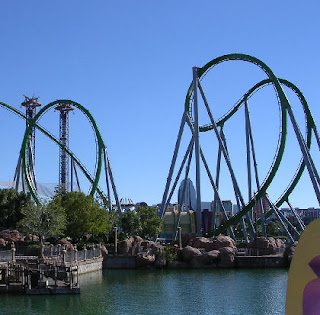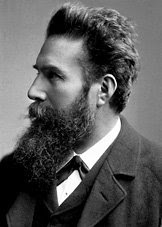I want a RIDE.
 The Roller Coaster:
The Roller Coaster:How does a roller coaster work?
What you may not realize as you're cruising down the track at 60 miles an hour is that the coaster has no engine. The car is pulled to the top of the first hill at the beginning of the ride, but after that the coaster must complete the ride on its own. You aren't being propelled around the track by a motor or pulled by a hitch. The conversion of potential energy to kinetic energy is what drives the roller coaster, and all of the kinetic energy you need for the ride is present once the coaster descends the first hill..
Once you're underway, different types of wheels help keep the ride smooth. Running wheels guide the coaster on the track. Friction wheels control lateral motion (movement to either side of the track). A final set of wheels keeps the coaster on the track even if it's inverted. Compressed air brakes stop the car as the ride ends.
Newton's third law of motion comes into play on the bumper cars. This law, the law of interaction, says that if one body exerts a force on a second body, the second body exerts a force equal in magnitude and opposite in direction on the first body. It's the law of action-reaction, and it helps to explain why you feel a jolt when you collide with another bumper car.
How do bumper cars work?
Bumper car rides are designed so that the cars can collide without much danger to the riders. Each car has a large rubber bumper all around it, which prolongs the impact and diffuses the force of the collision.
The bumper cars run on electricity, carried by a pole on the back of the car that leads up to a wire grid in the ride's ceiling. This grid carries the electricity that runs the car. Electrical energy carried to the cars from the grid is converted to kinetic energy, some of which is converted to heat.
What happens to the drivers?
When bumper cars collide, the drivers feel a change in their motion and become aware of their inertia. Though the cars themselves may stop or change direction, the drivers continue in the direction they were moving before the collision. This is why it's important to wear a seat belt while driving a real car, since otherwise you could suffer injury being thrown forward in a collision.
The masses of the drivers also affect the collisions. A difference in mass between two bumper car riders will mean that one rider experiences more change in motion than the other (or more of a jolt). The type of collision, velocity of the cars, and mass of the individual drivers all come into play in bumper car collisions.
 The Pendulum Ride:
The Pendulum Ride:Pendulum rides are a little like the swing sets you might remember from your childhood. Swings give you a feeling of flying in a controlled manner. You pump your legs to provide enough force to increase the height of the swing's arc, and enjoy the increased velocity of the downward swing. When you stop pumping, the swing gradually slows and then stops.
What causes the feeling of "weightlessness" on pendulum rides?
Riders often experience near-weightlessness as they approach the top of a pendulum ride. If the ride is the type that makes a complete 360-degree circle, they experience a feeling of complete weightlessness.
Feelings of weightlessness are not due to a decrease in forces of gravitation; people do not feel forces of gravity. What you feel is the force of a seat (or other external object) pushing on your body with a force to counteract gravity's downward pull. A 180-pound person at rest in his office chair experiences the seat pushing upwards on his body with a force of 180 pounds. Yet at the top of a pendulum ride, the same 180-pound person will feel less than this normal sensation of weight. At the very top of the pendulum ride, riders begin to fall out of their seats. Since a 180-pound person is no longer in full contact with his seat, the seat is no longer pushing on him with 180 pounds of force. Thus, the rider has a sensation of weighing less than his normal weight.
Why do riders experience high g-forces on pendulum rides?
As riders pass through the bottom of the circular arc, they often experience high g-forces. Once again, these g-forces are not evidence of increasing forces of gravitation, but the result of increases in the amount of force applied by the seat upon their bodies. Understanding this demands a little information about circular motion.
The motion of an object in a circle requires that there be a force directed toward the center of the circle (sometimes called a "centripetal force"). This means that at the bottom of the circular swing, there must be an upward force (since the circle's center is upward). Gravitational forces are always directed downward upon a rider's body; thus, gravitational forces cannot meet this centripetal force requirement. The seat must supply the centripetal force, pushing upwards on the rider with a force greater than gravity's downward pull. For a 180-pound person, the seat might have to supply 360 pounds of upward pull. This is twice the usual amount experienced by our 180-pound rider. For this reason, we would say the rider experiences 2 g's of force (a seat force that is 2 times the gravity force).
For more Amusement Park Physics. Click Here.


Thanks for the ride..I enjoyed it a lot.. =)
ReplyDeleteNice job Deby!
Hi Deby,
ReplyDeleteThanks for visiting my physics blog. I didn't know you have a physics blog, too. I like your posts by the way :-)